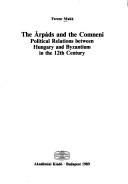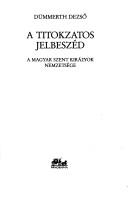| Listing 1 - 10 of 10 |
Sort by
|
Book
ISBN: 9788833131016 8833131017 Year: 2019 Publisher: Roma : Viella,
Abstract | Keywords | Export | Availability | Bookmark
 Loading...
Loading...Choose an application
- Reference Manager
- EndNote
- RefWorks (Direct export to RefWorks)
Queens --- History. --- Árpád, House of. --- Hungary --- History
Book
ISBN: 9631327108 Year: 1989 Publisher: Budapest Corvina
Abstract | Keywords | Export | Availability | Bookmark
 Loading...
Loading...Choose an application
- Reference Manager
- EndNote
- RefWorks (Direct export to RefWorks)
Arpad, House of --- Magyars --- Hungarians --- Hungary --- History --- -History --- -Árpád, House of. --- Magyars. --- -Arpad, House of --- Árpád, House of. --- -Árpád, House of --- Árpád, House of
Book
ISBN: 6156027467 Year: 2018 Publisher: Kronosz Könyvkiadó Kft.
Abstract | Keywords | Export | Availability | Bookmark
 Loading...
Loading...Choose an application
- Reference Manager
- EndNote
- RefWorks (Direct export to RefWorks)
Árpád, House of. --- Piast dynasty. --- Rurik, House of. --- Hungary --- Poland --- Russia --- History --- History --- History

ISBN: 963055268X Year: 1989 Publisher: Budapest Akadémiai Kiado
Abstract | Keywords | Export | Availability | Bookmark
 Loading...
Loading...Choose an application
- Reference Manager
- EndNote
- RefWorks (Direct export to RefWorks)
Comneni dynasty, --- Árpãd, House of --- Byzantine Empire --- Hungary --- Relations --- Árpád, House of --- Foreign relations --- 12th century

ISBN: 9632433300 Year: 1989 Publisher: Budapest Panoráma
Abstract | Keywords | Export | Availability | Bookmark
 Loading...
Loading...Choose an application
- Reference Manager
- EndNote
- RefWorks (Direct export to RefWorks)
Árpád, House of. --- Hungary --- Hungary --- Hungary --- Hungary --- Church history. --- History --- History --- Kings and rulers --- Religious life.
Book
ISBN: 9004326391 Year: 2016 Publisher: Leiden, Netherlands : Brill,
Abstract | Keywords | Export | Availability | Bookmark
 Loading...
Loading...Choose an application
- Reference Manager
- EndNote
- RefWorks (Direct export to RefWorks)
In Rituals and Symbolic Communication in Medieval Hungary under the Árpád Dynasty (1000 - 1301) Dušan Zupka examines rituals as means of political and symbolic communication in medieval Central Europe, with a special emphasis on the rulers of the Árpád dynasty in the Kingdom of Hungary. Particular attention is paid to symbolic acts such as festive coronations, liturgical praises, welcoming of rulers ( adventus regis ), ritualised settlement of disputes, and symbolic rites during encounters between rulers. The power and meaning of rituals were understandable to contemporary protagonists and to their chroniclers. These rituals therefore played an essential role in medieval political culture. The book concludes with an outline of ritual communication as a coherent system.
Political customs and rites --- Communication in politics --- Symbolism in politics --- History --- Árpád, House of. --- Hungary --- Kings and rulers --- History. --- Politics and government.

ISSN: 12552364 ISBN: 2868475337 2753500940 2753524963 2753531102 9782868475336 9782753500945 Year: 2008 Publisher: Presses universitaires de Rennes
Abstract | Keywords | Export | Availability | Bookmark
 Loading...
Loading...Choose an application
- Reference Manager
- EndNote
- RefWorks (Direct export to RefWorks)
Ce second tome de l’histoire de la Hongrie médiévale retrace des moments particulièrement glorieux du royaume magyar : l’apogée du pouvoir monarchique sous deux rois d’origine française, les « Angevins » Charles-Robert et Louis le Grand ; l’union avec le royaume de Bohême sous Sigismond (qui est aussi empereur du Saint-Empire) ; le gouvernement « éclairé » de Mathias, dernier roi « national ». Hélas les difficultés des années 1490- 1520 amènent la défaite catastrophique de Mohacs mais ce livre écrit par trois des meilleurs historiens hongrois montre que la victoire turque n’a pas entraîné une rupture totale avec le passé médiéval. Bien au contraire, c’est au cours des deux derniers siècles du Moyen Âge que se façonne l’identité hongroise : alors que la mise en valeur du vaste territoire hongrois se poursuit (sans connaître une crise comparable à celles des royaumes plus occidentaux) les structures sociales se mettent en place pour longtemps, avec la toute puissance d’une quarantaine de barons formant l’aristocratie, une noblesse moyenne et inférieure nombreuse, une bourgeoisie marchande souvent étrangère, une paysannerie qui perd sa liberté au début du xvie siècle… Si l’on ajoute que ce royaume, désormais bien intégré dans la Chrétienté latine, connaît un développement rapide de la culture écrite, on comprend que la lecture de ce livre apporte une information essentielle sur cette Europe du Centre-Est trop souvent méconnue.
Moyen âge, --- Hongrie --- --Regions & Countries - Europe --- History & Archaeology --- Central Europe --- Regions & Countries - Europe --- Hungary --- History --- Árpád, House of. --- Moyen âge, 476-1492 --- Acqui 2006 --- Chrétienté d'Occident --- histoire médiévale --- Moyen Âge --- monarchie féodale
Book
ISBN: 9789004301580 9004301585 9789004248335 9004248331 Year: 2015 Publisher: Leiden
Abstract | Keywords | Export | Availability | Bookmark
 Loading...
Loading...Choose an application
- Reference Manager
- EndNote
- RefWorks (Direct export to RefWorks)
In Slavery in Árpád-era Hungary in a Comparative Context , Cameron Sutt examines servile labour in the first three centuries of the Hungarian kingdom and compares it with dependent labour in Carolingian Europe. Such comparative methodology provides a particularly clear view of the nature of dependent labour in both regions. Using legislation as well as charter evidence, Sutt establishes that lay landlords of Árpádian Hungary frequently relied upon slaves to work their land, but the situation in Carolingian areas was much more complex. The use of slave labour in Hungary continued until the end of the thirteenth century when a combination of economic and political factors brought it to an end.
Slavery --- Landlords --- Árpád, House of. --- Landowners --- Abolition of slavery --- Antislavery --- Enslavement --- Mui tsai --- Ownership of slaves --- Servitude --- Slave keeping --- Slave system --- Slaveholding --- Thralldom --- Crimes against humanity --- Serfdom --- Slaveholders --- Slaves --- History --- Hungary --- Enslaved persons
Book
ISBN: 1641890258 164189024X Year: 2019 Publisher: Leeds : ARC Humanities Press,
Abstract | Keywords | Export | Availability | Bookmark
 Loading...
Loading...Choose an application
- Reference Manager
- EndNote
- RefWorks (Direct export to RefWorks)
A figure of crucial importance to scholarship on western and eastern Europe alike, King Coloman (1208-1241) here receives long-overdue scholarly treatment as a key figure of the thirteenth century. The Árpád prince ruled over a vast area in Central Europe which remained largely affiliated to the Western Church, territories that comprise modern-day Hungary, Slovakia, Croatia, and Bosnia. This study draws on Hungarian and other research that is inaccessible outside the region and places Coloman at the crossroads of Latin Christendom, Eastern Orthodoxy, and the Mongol Empire.
Kálmán, --- Galicia (Poland and Ukraine) --- Hungary --- Galichina (Poland and Ukraine) --- Galicja (Poland and Ukraine) --- Galizien (Poland and Ukraine) --- Halychyna (Poland and Ukraine) --- History. --- Kings and rulers. --- History --- HISTORY / Medieval. --- Coloman. --- Eastern Orthodoxy. --- Latin Christendom. --- Pope Gregory IX. --- medieval Bosnia. --- medieval Croatia. --- medieval Hungary. --- medieval Slovakia. --- Coloman, --- Árpád, House of
Book
ISBN: 9788322932100 8322932103 Year: 2011 Volume: 3329 182 Publisher: Wrocław Wydawnictwo uniwersytetu Wrocławskiego
Abstract | Keywords | Export | Availability | Bookmark
 Loading...
Loading...Choose an application
- Reference Manager
- EndNote
- RefWorks (Direct export to RefWorks)
Árpád, House of --- Historiography --- Hungary --- History --- Sources --- Árpád, House of. --- Macaristan --- Vengerskai︠a︡ Narodnai︠a︡ Respublika --- Magyar Népköztársaság --- Ungern --- Magyar Tanácsköztársaság --- Hungarian Republic --- Magyar Köztársaság (Republic) --- Oungaria --- Unkari --- Ungarn --- Hongrie --- Ungaria --- Ungheria --- Hungría --- Magyarország (Republic) --- Maďarsko --- Węgry --- Vengrii︠a︡ --- Hongarije --- VNR --- V.N.R. --- Hungaryah --- Hungari --- Hŏnggari --- Ungarii︠a︡ --- Republic of Hungary --- Hongaria --- Hongarye --- Republiek van Hongarye --- Macarıstan Respublikası --- Венгрыя --- Venhryi︠a︡ --- Mađarska --- Republika Mađarska --- Унгария --- Унгарската република --- Ungarskata republika --- Hongria --- República d'Hongria --- Republikang Unggaro --- Unggriya --- Mad̕arská republika --- Republica Ungrese --- Hwngari --- Gweriniaeth Hwngari --- Republik Ungarn --- Ungari --- Ungari Vabariik --- Ουγγαρία --- Δημοκρατία της Ουγγαρίας --- Dēmokratia tēs Oungarias --- República de Hungría --- Hungario --- Hungarujo --- Hungara Respubliko --- Hungaria --- Hungariar Errepublika --- Hungariako Errepublika --- Tjóðveldið Ungarn --- République de Hongrie --- Ungáir --- Poblacht na hUngáire --- Ungaar --- Pobblaght ny h-Ungaar --- 헝가리 --- Hunakalia --- Republik Hongaria --- Ungverjaland --- Lýðveldið Ungverjaland --- הונגריה --- אונגארן --- Мажарстан --- Mazharstan --- Мажарстан Республикасы --- Mazharstan Respublikasy --- Венгрия --- Венгрия Республикасы --- Vengrii︠a︡ Respublikasy --- Jamhuri ya Hungaria --- Madjaristan --- Repúvlika de Madjaristan --- רפובליקא דא מאגיאדיסטאן --- מאגיאדיסטאן --- Маджар --- Madzhar --- Маджар Республика --- Madzhar Respublika --- Respublica Hungarica --- Ungārija --- Ungārijas Republika --- Vengrija --- Vengrijos respublika --- Ungaïa --- Ungri --- Унгарија --- Република Унгарија --- Republika Ungarija --- Ungerija --- Hanekeria --- Унгар --- Ungar --- Tlācatlahtohcāyōtl Hungria --- Hongaarse Republiek --- ハンガリー --- Hangarī --- Hungrii --- Republikken Ungarn --- Ongria --- Republica d'Ongria --- Vengriya --- Vengriya Respublikasi --- Republika Węgierska --- República da Hungria --- Republica Ungară --- Republica Ungaria --- Венгерская Республика --- Vengerskai︠a︡ Respublika --- Lepulika o Hungary --- Republika e Hungarisë --- Unghirìa --- Madžarska --- Republika Madžarska --- Madźary --- Мађарска --- Република Мађарска --- Unkarin tasavalta --- Republiken Ungern --- Unggarya --- Republika ng Unggarya --- Majarstan Jȯmḣu̇rii︠a︡te --- Majoriston --- Macaristan Cumhuriyeti --- Угорщина --- Uhorshchyna --- Мадярщина --- Madi︠a︡rshchyna --- Угорська Республіка --- Uhorsʹka Respublika --- Oгорська Республіка --- Ohorsʹka Respublika --- Ongiri --- Oonguri --- Republik bu Oonguri --- Honharije --- Vengrėjė --- Vengrėjės Respoblėka --- 匈牙利 --- Xiongyali --- 匈牙利共和國 --- Xiongyali gong he guo --- Xiongyali Gongheguo --- Austro-Hungarian Monarchy --- Historiography. --- Magyar Republic --- Ongaria --- Árpád, House of - Historiography --- Hungary - History - 896-1301 - Sources --- BNUU --- БНУУ --- Bu̇gd Naĭramdakh Ungar Uls
| Listing 1 - 10 of 10 |
Sort by
|

 Search
Search Feedback
Feedback About UniCat
About UniCat  Help
Help News
News